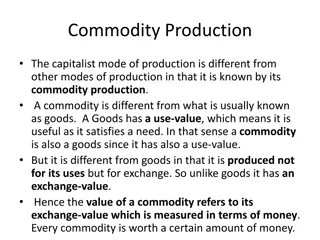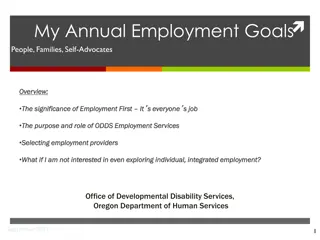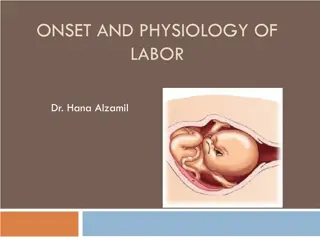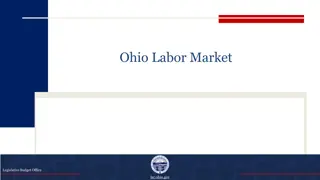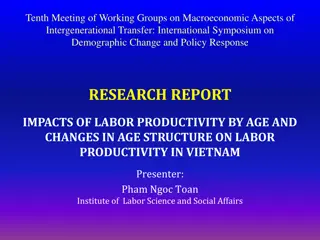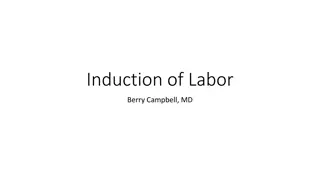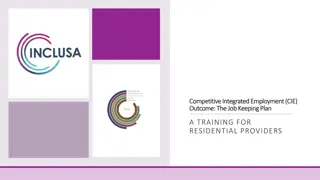2018 Labor and Employment Seminar Overview
Delve into the complexities of pay equity, wage gaps, and relevant federal laws discussed at the 2018 Labor and Employment Seminar. Explore current state laws, recent case law, and recommendations to address pay discrimination.
Download Presentation

Please find below an Image/Link to download the presentation.
The content on the website is provided AS IS for your information and personal use only. It may not be sold, licensed, or shared on other websites without obtaining consent from the author.If you encounter any issues during the download, it is possible that the publisher has removed the file from their server.
You are allowed to download the files provided on this website for personal or commercial use, subject to the condition that they are used lawfully. All files are the property of their respective owners.
The content on the website is provided AS IS for your information and personal use only. It may not be sold, licensed, or shared on other websites without obtaining consent from the author.
E N D
Presentation Transcript
2018 Labor and Employment Seminar Grant Collins Felhaber Larson 220 South 6th Street, Suite 2200 Minneapolis, MN 55402
Pay Equity and the New Glass Ceiling
Summary Current state of the wage gap Federal laws prohibiting pay discrimination Equal Pay Act of 1963 Title VII of the Civil Rights Act of 1964 State laws Recent case law regarding pay discrimination Recommenations
What is Pay Equity? Equal pay for equal work. Origin: Male v. Female Now, many state laws require equal pay across all groups Sex, race, national origin, ethnicity, etc. Pay equity is growing more complex as pay and work structures evolve.
The Wage Gap Historically The wage gap has been slowly closing over time. Ariane Hegewisch, The Gender Wage Gap: 2017; Earnings Differences by Gender, Race, and Ethnicity (2017).
The Wage Gap Today At the 10th percentile of wages, women earn 92 cents for every dollar paid to men. At the 95th percentile of wages, women earn 74 cents for every dollar paid to men. The average female worker loses more than $530,000 over the course of her lifetime. The average college-educated female worker loses nearly $800,000 over the course of her lifetime. Elise Goulding et al., What is the Gender Pay Gap and is it Real? (2016).
The Stalled Wage Gap Since 1973: 60% of the wage gap change due to drop in men's real earnings. 40% of change due to increase in women s earnings. At current pace, the Institute for Women's Policy Research estimates that it will take 50 years to close the wage gap.
Federal Laws Equal Pay Act of 1963 (EPA) Title VII of the Civil Rights Act of 1964 (Title VII) Lilly Ledbetter Fair Pay Act of 2009 Other federal laws ban discrimination in pay based on: Age (ADEA) Disability (ADA)
Federal Laws Enforcement EEOC -- independent federal agency created by Congress in 1964 to eradicate discrimination in employment. EEOC wields great power and discretion in achieving the goal of eradicating discrimination in employment. Under EPA and many state laws, plaintiff can bring a claim privately instead of first filing a charge with the EEOC or state equivalent.
Federal Laws Enforcement The EEOC has identified pay equity as one of six enforcement priorities. In recent years, the EEOC has increased the number of EPA claims it has filed against employers. o2017: 11 EPA claims o2016: 6 EPA claims o2015: 5 EPA claims
Equal Pay Act Creates as an amendment to the minimum wage provision of the FLSA. Employers may not pay men and women differently for equal work. The EPA defines equalwork as work done: In the same location; Under similar working conditions; and Using equal skill, equal effort, and equal responsibility.
Equal Pay Act What is equal work? Substantially equal not identical. Look at job content, not title. What is equal pay? All forms of pay. Examples: oSalary oOvertime and bonuses oVacation oBenefits, stock options, and profit sharing.
Equal Pay Act Affirmative Defenses: Employers may provide unequal pay for equal work, if the differential in pay is attributable to: A seniority system; A merit system; A system based upon quality or quantity of production; or Any factor other than sex.
Equal Pay Act Affirmative Defenses: Merit, seniority, or incentive systems must be: oBased on predetermined criteria. oApplied consistently and even-handedly. oCommunicated to all employees. Must eliminate arbitrary decision making.
Equal Pay Act Affirmative Defenses: Merit system: oRaises based on high performance oMust evaluate employees regularly oCan contain subjectivity (supervisor rating), but must be otherwise objective.
Equal Pay Act Affirmative Defenses: Incentive system: oPay is tied to quantity or quality of production oCommon in sales jobs (i.e. commission) oLike merit systems, criteria must be objective and uniformly applied. Seniority system: oPay primarily based on length of service.
Equal Pay Act Affirmative Defenses: For all bona fide systems, the employer must show that the system is the true reason for the difference in pay. Existence of system is not sufficient. System must be related to business and to job requirements.
Title VII of the Civil Rights Act of 1964 (Title VII) Prohibits discrimination in all aspects of employment. Broader than EPA. Prohibits wage discrimination on the basis of race, color, sex, religion or national origin. Prohibits wage discrimination even when the jobs are not identical. Thus, employee who has EPA claim likely has viable Title VII claim.
Title VII of the Civil Rights Act of 1964 (Title VII) Must show: Discriminatory intent; or Facially neutral policy with disparate impact. Need not show equal work. Same affirmative defenses available under EPA are available under Title VII.
Lilly Ledbetter Fair Pay Act of 2009 The Act overturned the Supreme Court s decision in Ledbetter v. Goodyear Tire & Rubber Co., 550 U.S. 618 (2007). The court s decision restricted the time period for filing complaints of pay discrimination. The Act provides that the statute of limitations clock resets after each discriminatory pay decision. Thus, compensation is a separate violation. each paycheck that contains discriminatory
State & Municipal Laws Several states have taken lead in combatting pay equity. Contain broader employee protections than federal laws Mandate employers to make dramatic changes to workplace pay equity practices. Audits Compliance measures Hiring practices
Minnesota Local Government Pay Equity Act (1984) Requires all public jurisdictions such as cities, counties, and school districts to eliminate any gender-based wage inequities. Must report pay equity implementation report every 3 years. Non-compliance results in fines and funding reduction. Applies only to gender not race, ethnicity, etc.
Minnesota Statute has been effective in eliminating disparity. 1976: 4% of managers were women 25% of professional employees were women 2014: 30,000 state employees received raises 50.3% of state employees were female 46% of professional-level employees were female Office on the Economic Status of Women, Pay Equity: The Minnesota Experience (Feb. 2016)
California CA Equal Pay Act (1949) CA Fair Pay Act (2016) General rule: No wage disparity for substantially similar work. Substantially similar work is viewed as a composite of skill, effort, and responsibility. This is broader than the EPA language equal work.
California Other protections: Employer cannot justify pay disparity based on prior salary. Plaintiff offices/facilities. can compare wages between multiple Cannot prohibit employees from disclosing or discussing wages with others. Can bring private right of action or file complaint with state division of labor.
California Defenses: Seniority; Merit; A system that measures quality or quantity of production; or A bona fide factor other than sex (e.g., education, training, or experience) consistent with business necessity.
New Jersey Similar to California But, workers being compared must work in same geographic region. Not limited to gender prohibits discrimination across all protected classes. Employer cannot prohibit discussion of wage information. Can recover liquidated damages for willful violations. 300% of wages recoverable.
Other States Washington and Maryland (similar to NJ and CA) Oregon and Massachusetts Provide employers some form of safeharbor if conduct pay equity analysis. MA requires analysis within three years of action. Cities have also enacted pay equity ordinances E.g. New York City banned questions about salary history in hiring process.
Significant Cases Salary History Rizo v. Yovino (9th Cir. 2017) Plaintiff, a public employee, challenged under EPA the county s practice of using salary history to determine starting salary. Plaintiff started at minimum-level salary based on prior job pay. Pay was below that of male peers. County said pay policy was not based on sex.
Significant Cases Salary History Rizo v. Yovino (9th Cir. 2017) 9th Circuit ultimately held that policy violated EPA. Reliance on past wages simply perpetuates the past pervasive discrimination that the [EPA] seeks to eradicate. Prior job salary is not job related.
Significant Cases Salary History Lauderdale v. Illinois Dep t of Human Servs. (7th Cir. 2017) Upheld policy that based pay increases in part on prior salary. Court: no EPA violation unless pay discrepancy based on sex. No proof here that plaintiff s prior wages were lower because of sex discrimination.
Significant Cases Salary History Taylor v. White (8th Cir. 2003) Female army employee challenged policy that resulted in her receiving lower salary than male counterparts. Army argued that pay disparity was based on a salary retention policy intended to retain skilled workers and protect workers salaries. Court: prior salary or salary retention policy is a factor other than sex allowed under EPA.
Significant Cases Summary: Salary History Federal circuit courts are split as to whether employers can rely solely on prior salary to meet the legitimate factor other than sex defense to an EPA claim. o7th and 8th Circuits: Employers can use prior salary to justify a pay disparity o6th, 9th, 10th, 11th Circuits: Use of a prior salary cannot alone justify a pay disparity. Other Circuit Courts: No clear decision in either direction.
Significant Cases EPA Retaliation Donathan v. Oakley Grain, Inc. (8th Cir. 2017) Female employee alleged she was not given same bonuses as male coworkers, among other inequities. She emailed company president. Plaintiff s manager then told president of likely layoff s at facility. Plaintiff laid off 8 days later. DC held that company had valid reason to terminate
Significant Cases EPA Retaliation Donathan v. Oakley Grain, Inc. (8th Cir. 2017) 8th Circuit reversed, holding that there was sufficient evidence to believe plaintiff s complaint was basis for termination.
Significant Cases Who is an Employee under EPA? Courts apply multi-factor test to determine employment status. Factors include: Company s ability to hire and fire employee; Extent of company supervision over employee; Sharing of profits, losses, and liabilities; Reporting structure.
Significant Cases Who is an Employee under EPA? Cambpell v. Chadbourne & Parke LLP (SDNY 2017) Female partner at law firm paid less than male partners brought claim under EPA Firm argued partner is not an employee under the EPA Court disagreed, and denied summary judgment to firm.
Significant Cases Class Actions Many pay equity claims are litigated as class actions. Challenge employer s formal policy, or allege pattern or practice. New state laws have looser definitions of equal work, which may allow for larger classes of plaintiffs.
Significant Cases Class Actions Barrett v. Forest Laboratories, Inc. (SDNY 2015) 11 female pharmaceutical sales representatives alleged that company was paying male employees of equal or lesser seniority more money. Plaintiffs successfully certified a nationwide collective action under the EPA. Notice was sent to 2,000 potential class members. Over 350 opted in. Settled in 2017 for $4 million.
Cases to Watch Ellis v. Google, LLC (San Francisco Superior Court) Class action under the California Fair Pay Act Plaintiffs broadly challenged Google s company-wade compensation policy. Plaintiffs initially included almost all female employees Court initially dismissed complaint as too broad. Plaintiffs narrowed claims to 30 job titles among 6 job families. Court allowed complaint to proceed to discovery.
Cases to Watch Kassman v. KPMG, LLP (SDNY) Class action for pay and promotion discrimination under EPA and Title VII. After certification of EPA class, over 1,100 members opted in. The plaintiffs seek over $400 million in damages.
Recommendations Pay equity statutes are moving quickly Almost every state has a pay equity law. Laws are broadening to protect across sex, race, ethnicity, national origin, religion, etc. Laws contain looser definition of equal work make it easier to make out a claim.
Recommendations Ensure Compliance with Current Law Identify whether pay disparities exist. oConduct analysis of pay across and between different groups. Review hiring and promotion policies oIdentify whether policies promote pay disparities. Hire expert to review current merit, performance, incentive, or seniority systems oMust ensure system will justify any pay disparities.
Recommendations Get Ahead of the Game for Future Legislative Changes Review and amend policies regarding employee discussion of wages Increase pay transparency. Compare pay and policies with other company offices or locations.
Questions Thank you!













